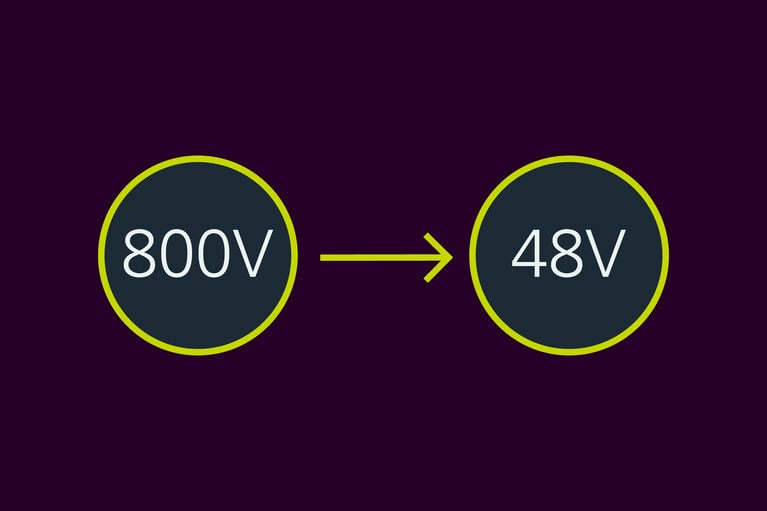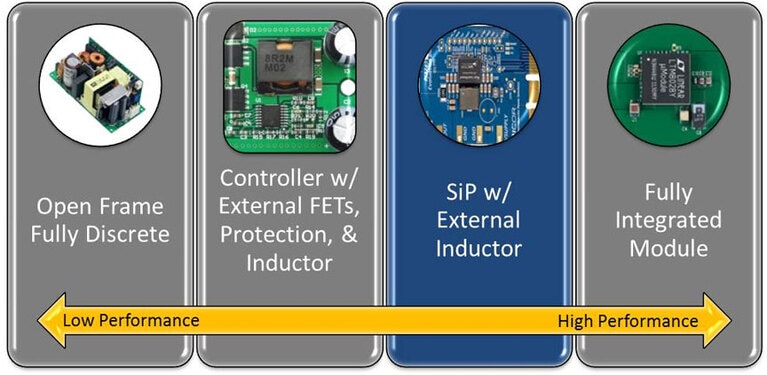
電源模組加速汽車從 800V 到 48V SELV 的轉變之路
Vicor BCM6135 為主動懸掛系統解决了歷史性的電源設計問題。雙向並快速瞬變的 DC-DC 轉換器對全新的設計至關重要
Switching regulator solutions are offered in various levels of integration, offering a broad spectrum of performance, features, and packaging. They range from open frame discrete solutions to fully integrated modules.
Figure 1. Different levels of Integration in Regulator Solutions
There are numerous tradeoffs to each type of design, but the one that takes the lead in performance vs. cost for the 50W to 100W-type point-of-load design is the SiP-type regulator, especially when combined with a ZVS switching topology. These SiP-based regulators, like our Vicor ZVS regulators, are built on an over-molded substrate, which integrates power FETs, passive components, and predefined compensation components. This packaging approach integrates the majority of the regulator system except for the inductor and input/output capacitors.
With an external inductor, board-level heat dissipation is superior vs. the module approach where heat is concentrated in one location (the inductor can generate 40-50% of the total regulator heat). Without being constrained by package profile limitations external inductor design can be optimized for efficiency. Lower switching losses of the Vicor ZVS topology translate into higher efficiency, lower heat dissipation, and higher density. On the cost side, competitive modules from various IC vendors, including Vicor, typically hold a 1.5x to 3x premium over SiP-based regulators.
Considering that module performance lags vs. SiPs, and they cost more, designers might ask if the modules’ small gains in density are really worth it. At least for the Vicor-based SiP regulators, our density (power delivery vs. x-y board area consumption) is on par with modules, even when including all the required components (the external inductor and input/output capacitors). This is because the modules also require external input/output capacitance. Vicor’s ZVS topology supports high frequency operation (without sacrificing efficiency) and this allows for smaller passives.
Applications vary and hence there is a need for various levels of regulator integration, however, when looking at efficiency, size, and cost, our ZVS regulators set a performance/cost metric that surpasses that of many fully integrated modules. This can be counter intuitive to many designers especially when not aware of the added benefits of a ZVS switching topology regulator.
Related content
Product overview: ZVS buck switching regulators
電源模組加速汽車從 800V 到 48V SELV 的轉變之路
Vicor BCM6135 為主動懸掛系統解决了歷史性的電源設計問題。雙向並快速瞬變的 DC-DC 轉換器對全新的設計至關重要
Disaggregating power in data centers
The Vicor BCM6135 solves historic power design problem for active suspension. Bidirectional and fast-transient DC-DC converter essential to new design
用於電動汽車供電網路(PDN)的高壓母線轉換器 48V 電源模組
48V 架構可减少損耗,有助於實現更小、更輕的電源系統。Vicor DC-DC 轉換器超越分立式設計,優化電源系統
純電動汽車的技術進步正推動銷量增長,但車輛安全性和可靠性才是長期生存的關鍵
Vicor BCM 和 DCM可輕鬆實現並聯,從而减少 DC-DC 轉換器的尺寸,其高效率和高密度可提升性能



